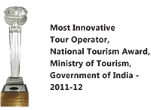If you are in need of some peace and quiet, and need to get away from the rat race for a while, look no further than Adventure River Cruises’ Assam packages. Choose how long you want to escape, and board our elegant river queen, the MV Mahabaahu. Our staff will take you though a fantabulous experience of the glittering state through its main waterway, the Brahmaputra.
Given the location of Assam, it is no wonder that it is the gateway to the Northeast territories of India. Consequently, it is then not so surprising to observe the sheer diversity of culture and tradition that the state can boast of. As part of an area that can claim to have the largest number of tribal cultures, it is home to many tribes, and their stories.
One of them, and certainly not the least, is the Mishing tribe – historically known as the Miri. With origins in Tibet and China, the Mishing people are spread over ten districts in Assam, and even a few in Arunachal Pradesh. Majuli, one of the largest river islands in the world, is mostly inhabited by the Mishing people. Related to the Tani communities of the hills of their origins, the Mishing are now plains-dwellers who live their lives with the gentle gurgles of the Brahmaputra to serenade them. However, given that the river is a capricious beast, they have also learned to deal with the fury that it can show. Most Mishing villages are close to the river, and as such their houses rest on five foot tall stilts. Jovial folk with friendly dispositions, the Mishing people are candid in expressing happiness and disagreement. Their hospitality is also legendary, and all guests are welcomed readily.  Despite living on the fertile banks of the Brahmaputra, due to frequent flooding and dated cultivation practices, they have not been able to rise up the economic scale. Until the construction of embankments by the government, their houses were also largely temporary, staying true to their nomadic origins. Typically, a Mishing house is large enough to accommodate thirty to forty people, all living in a large communal hall. In spite of a number of changes that have occurred in the socio-political-religious life of Assam, this colourful ethnic group have maintained their traditional socio-cultural traits for centuries. The main festival of the tribe is their harvest festival, which happens in the month of February, it is called Ali-Lye-Ligangin.
Despite living on the fertile banks of the Brahmaputra, due to frequent flooding and dated cultivation practices, they have not been able to rise up the economic scale. Until the construction of embankments by the government, their houses were also largely temporary, staying true to their nomadic origins. Typically, a Mishing house is large enough to accommodate thirty to forty people, all living in a large communal hall. In spite of a number of changes that have occurred in the socio-political-religious life of Assam, this colourful ethnic group have maintained their traditional socio-cultural traits for centuries. The main festival of the tribe is their harvest festival, which happens in the month of February, it is called Ali-Lye-Ligangin. All the tribes that live in the Northeast have distinct cultures and traditions, expressing this variety most clearly through their choice and production of fabric. The Mishing are no exception to this rule. The designs and traditional motifs, in their case a diamond pattern, are a process of evolution. These are not designs made by individuals, but an aesthetic that imbibes cultural significance. The artisans carry on their traditions not out of any sense of compulsion, but out of what is almost a sacred duty.
All the tribes that live in the Northeast have distinct cultures and traditions, expressing this variety most clearly through their choice and production of fabric. The Mishing are no exception to this rule. The designs and traditional motifs, in their case a diamond pattern, are a process of evolution. These are not designs made by individuals, but an aesthetic that imbibes cultural significance. The artisans carry on their traditions not out of any sense of compulsion, but out of what is almost a sacred duty. The handlooms and weaves are the preserve of the women of the Mishing, who are often trained from childhood. With a staunch tradition and a good understanding of natural dyes they produce a prodigious amount of fabric in different styles, ranging from their colourful traditional wear, to more modern styles such as shirts and skirts. They work mainly with cotton, which they grow and spin on yarns themselves, and sparingly with silk. And of all the types of silk in the world, Assam has a comfortable monopoly on the production of muga silk and eri silk. It is the Mishing tribe that mostly works with eri silk, which has a substantial impact of the socio-economic lives of the people.
The handlooms and weaves are the preserve of the women of the Mishing, who are often trained from childhood. With a staunch tradition and a good understanding of natural dyes they produce a prodigious amount of fabric in different styles, ranging from their colourful traditional wear, to more modern styles such as shirts and skirts. They work mainly with cotton, which they grow and spin on yarns themselves, and sparingly with silk. And of all the types of silk in the world, Assam has a comfortable monopoly on the production of muga silk and eri silk. It is the Mishing tribe that mostly works with eri silk, which has a substantial impact of the socio-economic lives of the people. Given the advancement of time, and the rising need to adapt to the ever-changing market, weavers are now compelled to hash out designs which pander to the demands of commercialisation, and worse still – urbanisation. However, there seems to be a rising awareness and desire to revive and protect their indigenous identity, and consequently there is a growing movement to preserve and revive the rites, stories, and customs – particularly those to do with weaving. A young weaver’s aesthetic might be inspired by a lot of things, all the elements of her verdant surroundings, but also by legends and tales – of the creation of the universe, of the Sun which they call donyi, and believe to be the tribe’s mother, with the moon, which they call polo, being the father. Stories about the river flooding, and other calamities also find their way into the tapestry of their weave. One of the more popular, and recurring, motifs in Mishing weaves is the diamond, which represents the chang ghar – temporary structures that are crucial to the well being of the tribe. They are houses with raised platforms, constructed with bamboo, timber, and thatch. They protect the people from floods and heavy rains, and are part of the threads that tie their society together.
Given the advancement of time, and the rising need to adapt to the ever-changing market, weavers are now compelled to hash out designs which pander to the demands of commercialisation, and worse still – urbanisation. However, there seems to be a rising awareness and desire to revive and protect their indigenous identity, and consequently there is a growing movement to preserve and revive the rites, stories, and customs – particularly those to do with weaving. A young weaver’s aesthetic might be inspired by a lot of things, all the elements of her verdant surroundings, but also by legends and tales – of the creation of the universe, of the Sun which they call donyi, and believe to be the tribe’s mother, with the moon, which they call polo, being the father. Stories about the river flooding, and other calamities also find their way into the tapestry of their weave. One of the more popular, and recurring, motifs in Mishing weaves is the diamond, which represents the chang ghar – temporary structures that are crucial to the well being of the tribe. They are houses with raised platforms, constructed with bamboo, timber, and thatch. They protect the people from floods and heavy rains, and are part of the threads that tie their society together.

















Leave a Reply
You must be logged in to post a comment.